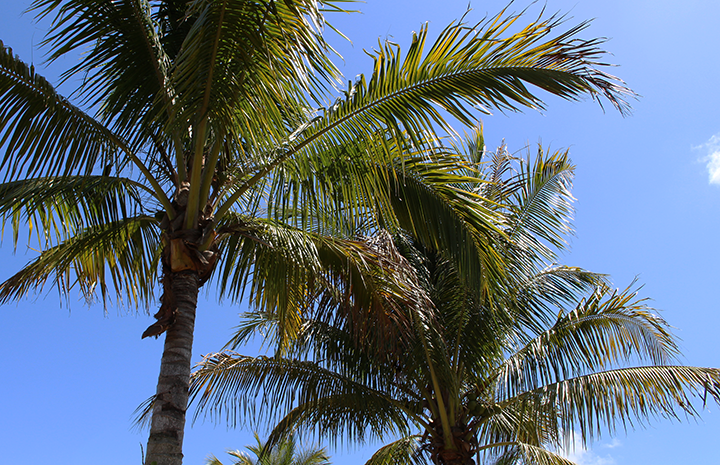
Glance at a postcard from Florida, and you might be tempted to think that all palms are straight, coconut-bearing, with long, arching fronds. But palms exist throughout the tropical and subtropical world, and their appearances are as varied as their native regions. There are palms with massive, fan-shaped fronds. Palms that climb like vines. Palms that bear fruits. Palms that are bushy like shrubs and species that tower over forest canopies. They exist in a variety of habitats, “from the tropical forest to the blazing-hot desert,” says Director of Collections Nick Ewy. The trunks can be as varied as the fronds: smooth, ringed, spiky, singular, clustered, lattice-like, shaggy like a beard.

Palms serve as important natural resources. They produce oil, sugar, wax, fruit, and material for thatching, basket-making, furniture (rattan is a type of palm), and textiles. Naples Botanical Garden’s palm collection — one of its largest — includes 223 species and some 1,500 trees on display. “We’re one of the few gardens in the United States that can have an outdoor palm collection. That really sets us apart,” Ewy says. Many of ours are showpieces, designed to give guests a taste of the palm family’s vast diversity. We tend others to conserve them, such as Attalea crassispatha (located in the Kapnick Caribbean Garden) and Dypsis leptocheilos (located on the Performance Lawn and near the Grove). These are among the 23 species listed as “endangered” or “critically endangered” by the International Union for Conservation of Nature’s Red List, a global information source on extinction risk. We also safeguard a collection of Florida thatch palms (Thrinax radiata), critical because they occur on the northernmost end of their range, making them genetically distinct, and because their coastal habitat is imperiled.
Allagoptera arenaria
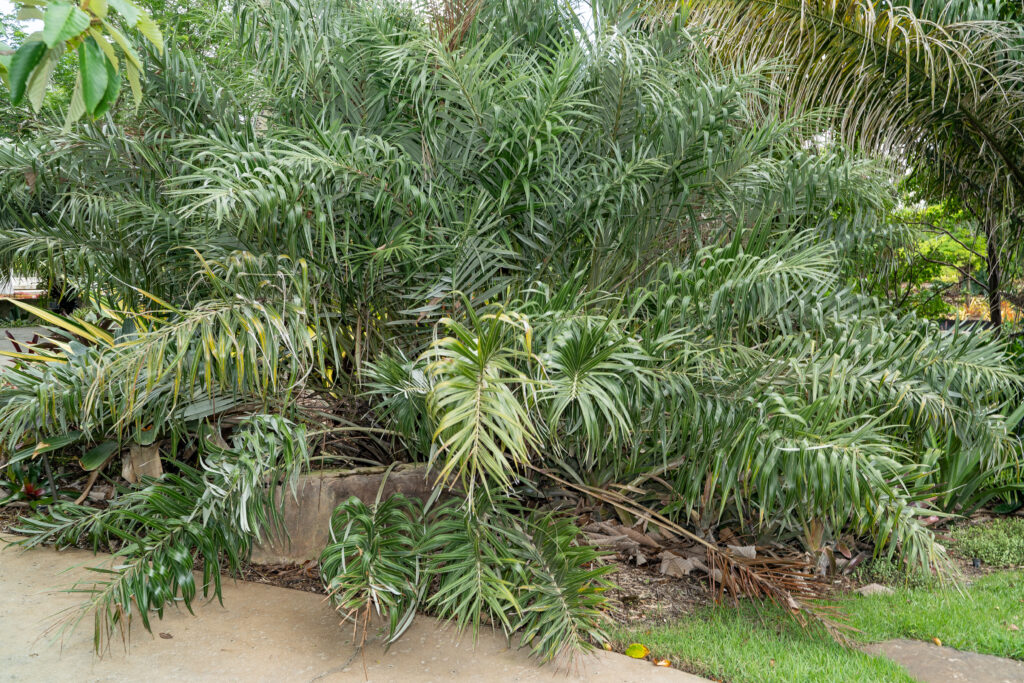
Native to Brazil, the seashore palm’s fruits are reminiscent of corn on the cob. Oblong and nugget-like, they are eaten raw, pressed into juice, or cooked into jam. The genus name, Allagoptera, comes from the ancient Greek words meaning “change” and “wing,” referencing the swirling, changing pattern of the leaves, and the species’ name, arenaria, is derived from the Latin word for “sandy,” its preferred soil type. Based on fossil records, the seaside palm is regarded as among the most ancient of palms.
Where to see it: In the Kapnick Brazilian Garden, as you make your way down from the Roberto Burle Marx mosaic.
Attalea cohune
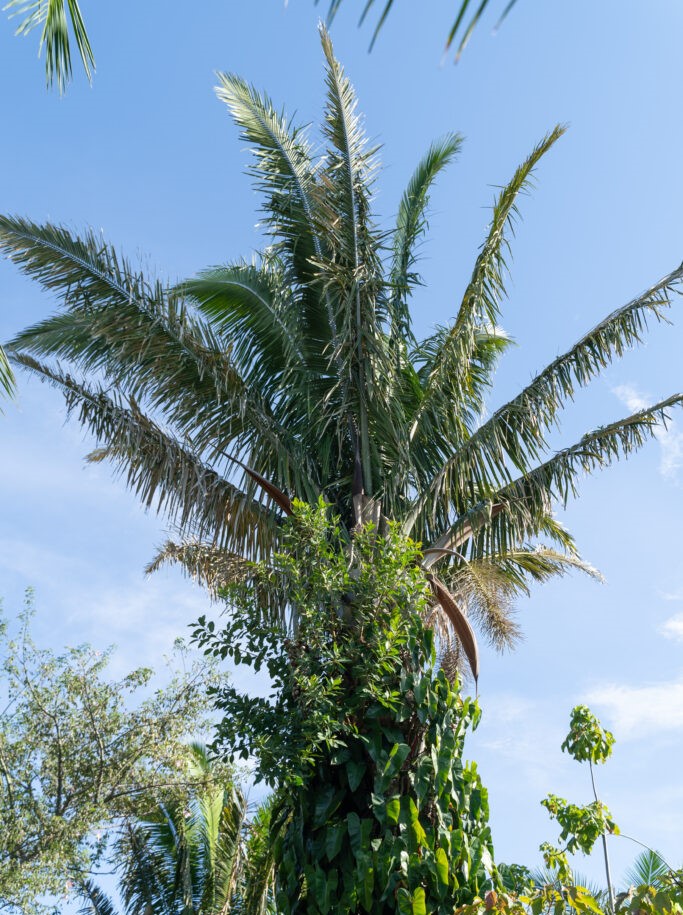
Towering as high as 80 feet, South America’s cohune palm is both aesthetically impressive and highly useful. Native people used it as a food and a wine, extracting the palm hearts and sap, respectively. Cohune oil serves as a lubricant, cooking oil, lamp oil, and soap ingredient. Its long fronds are used as a thatching material for roofs, and its fruits can be turned into a sweet delicacy or serve as livestock feed.
Where to see it: Along the winding pathway in the Kapnick Brazilian Garden.
Nypa fruticans
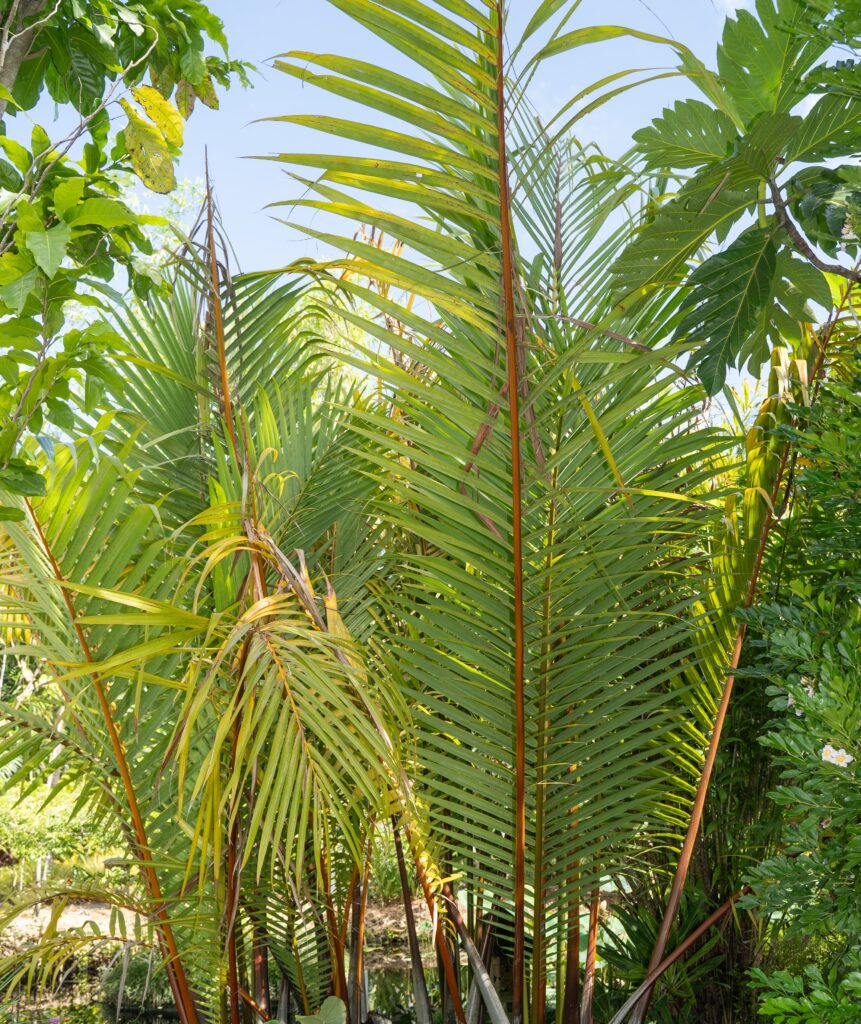
The trunks of the nipa or mangrove palm grow underground with long, leafy fronds emerging from the surface. These Southeast Asian trees thrive in estuaries, where fresh water meets the sea. Its fronds have been used for roofs, baskets, and tobacco rolls. Its sugar-rich sap can be converted into ethanol or butanol. The fruits are eaten as a dessert, flower petals have been used in teas, and the base of its stems often harbor mussels that are roasted and eaten.
Where to see it: In the Lea Asian Garden pool next to the Thai Pavilion.
Tahina spectabilis
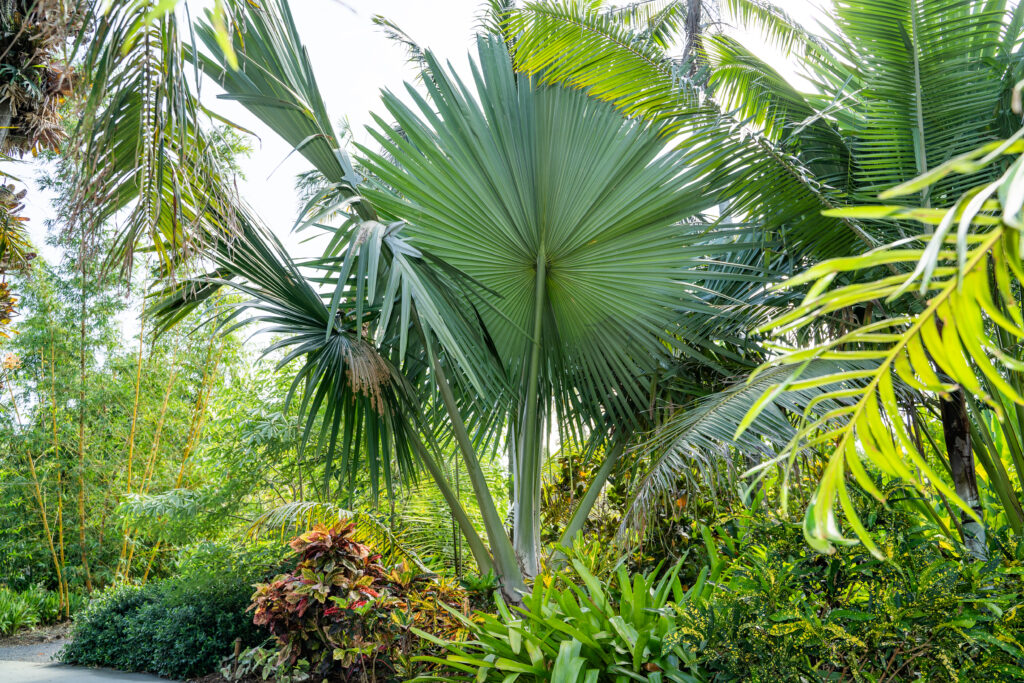
The Tahina palm was discovered in 2006 when a cashew farmer in Madagascar stumbled upon it. The International Institute for Species Exploration dubbed it one of the top 10 species discoveries in 2008 once the Royal Botanic Gardens, Kew, confirmed it was a unique new genus. There is only one known wildgrowing population of this towering palm. Conservationists are working to increase its numbers by sharing seeds with botanical gardens, including ours.
Where to see it: Along the pathway between the Lea Asian Garden and the Grove.
Copernicia macroglossa
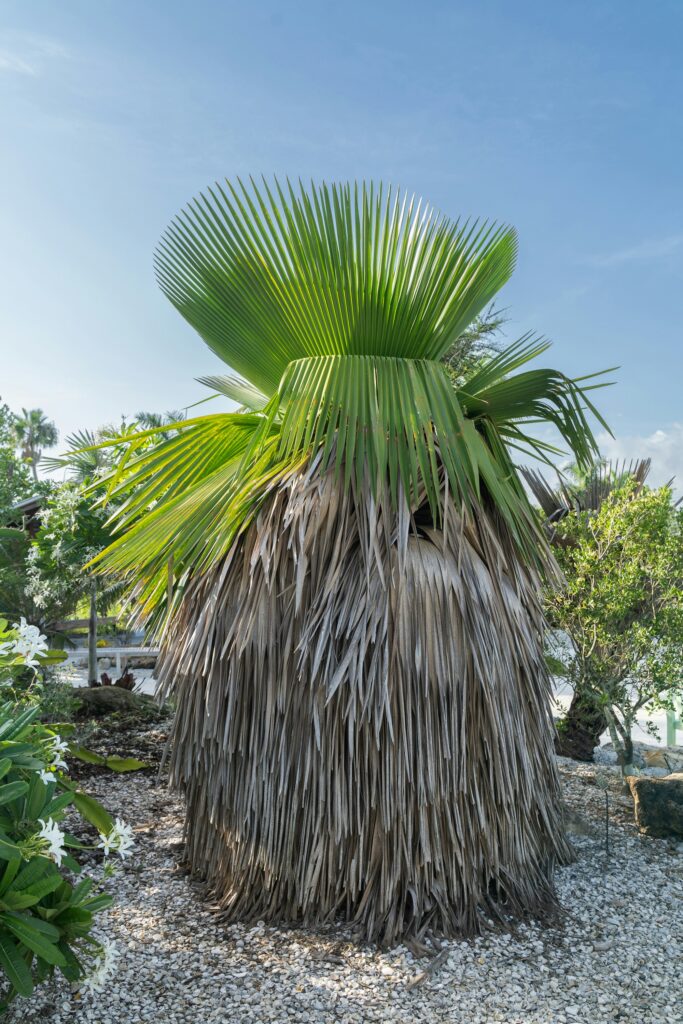
This Cuban native is dubbed “petticoat palm.” The large, circular, erect fronds have almost no leafstalk (the stemlike structure that attaches fronds to branches), and fan out in a spiral shape from the trunk. The tree doesn’t shed the leaves as they die, and they droop into a dress-like shape beneath the new growth if not removed.
Where to see it: In the arid habitat at the tip of the Kapnick Caribbean Garden. From Nina’s Pavilion, follow the paved pathway along Lake Tupke and look to your right.
Chambeyronia macrocarpa
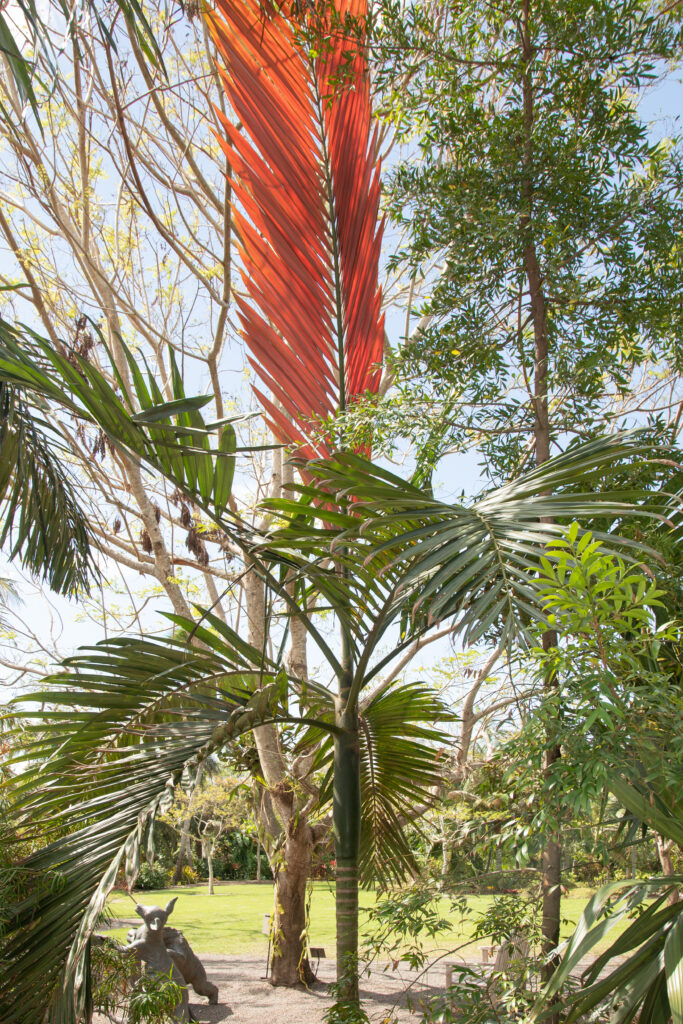
Just as its common name implies, the flame-thrower palm periodically produces a bright red new leaf, which juts from its crown and fades to green after about 10 days. This ancient palm (records date it back to the age of dinosaurs) originates in New Caledonia in the South Pacific where it is the national tree.
Where to see it: There are several at the Chabraja Visitor Center.
This article originally appeared in the Fall 2023 issue of Cultivate, the Garden’s magazine.

Rare and Whimsical Palms Among the Garden’s Newest Addition
The newest addition to the Garden’s palm collection comes from Florida Foliage Growers, operated by grower and collector George Zammas. The Garden acquired 27 specimens. Many of them are found only on islands such as Cuba, Haiti, and Vanuatu in the South Pacific, where habitat loss or overuse renders them vulnerable. Three are listed as endangered or critically endangered, and one, Pelagodoxa henryana, is extinct in the wild.
All are handsome palms with striking characteristics. For example, Itaya amicorum, which was discovered on the banks of a Peruvian river in 1972, has 7-foot-wide leaves that are almost as big as its 10-foot trunk.
Copernicia baileyana, with its enormous blue-green fan-shaped fronds, is a majestic statement when it reaches its full 60-foot height. Its relative, Copernicia ekmanii, is rare in collections and strikingly beautiful, with pale blue to almost white leaves. Copernicia macroglossa is known for its erect spiraling leaves with no leaf stem. As a result, when the leaves age, they leave a petticoat of brown around the trunk with bright green fronds rising above it.
The collection can be seen throughout the property, including in the Kapnick Caribbean Garden, main entry drive, and at the Evenstad Horticulture Campus upon its completion.
This acquisition was supported, in part, by the Martin Foundation.

About the Author
Liz Chehayl is the Brian Holley Curator of Collections at Naples Botanical Garden.

About the Author
Jennifer Reed is the Garden’s Editorial Director and a longtime Southwest Florida journalist.

